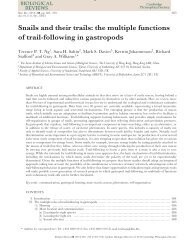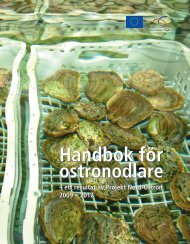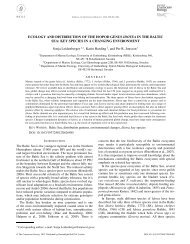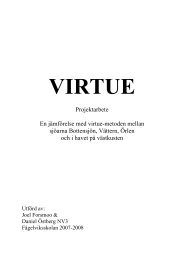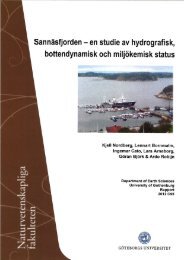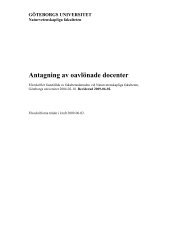Dr Helen Jane Fraser
Fraser, H.J.: "Interstellar Ices and the Gas-dust Interaction." (Tutorial)
Fraser, H.J.: "Interstellar Ices and the Gas-dust Interaction." (Tutorial)
- No tags were found...
You also want an ePaper? Increase the reach of your titles
YUMPU automatically turns print PDFs into web optimized ePapers that Google loves.
<strong>Dr</strong>. <strong>Helen</strong> <strong>Jane</strong> <strong>Fraser</strong><br />
(h.fraser@phys.strath.ac.uk)<br />
Department of Physics<br />
University of Strathclyde<br />
(HF ubiquitous)…
Not exhaustive<br />
1. Ice + Interstellar = > 600 hits (2005 – 2011)<br />
3. + Ion* = > 157 hits (2005 – 2011)<br />
• Yet not much of this yet filtering through to gas-grain models<br />
(they have a hard enough time already!!)<br />
• Lots of good work – not always angled to make it accessible to<br />
multidisciplinary audience<br />
• Experiments with ions and radicals per see not easy!! (Nor is<br />
theory)<br />
Recent nice (review) papers (with loads of refs in them):<br />
- Ice in space: surface science investigations of the thermal desorption of model interstellar ices<br />
on dust grain analogue surfaces<br />
Burke & Brown, PCCP, 12, issue 23, 5947 – 5969 (2010)<br />
- Ice surface reactions: A key to chemical evolution in space<br />
Watanabe & Kouchi PROGRESS IN SURFACE SCIENCE, 83, issue 10-12, 439 – 489 (2008)<br />
- Reaction Networks for Interstellar Chemical Modelling: Improvements and Challenges<br />
Wakelam, et al. SPACE SCIENCE REVIEWS, 156, Issue: 1-4, 13-72 (2010)<br />
-The Spitzer Ice Legacy<br />
Oberg et al ApJ (2011) 2011arXiv1107.5825O
Role of Ice<br />
in “Star<br />
and Planet<br />
Formation”
Icy Grains in Protostellar Envelopes<br />
Credit: NASA/JPL-Caltech/R. Hurt (SSC)
Figure 1; This image from NASA's Spitzer Space Telescope shows the<br />
"mountains" of gas and dust in a dense molecular cloud where stars are born.<br />
Dubbed "Mountains of Creation" by Spitzer scientists, these towering “peaks”<br />
are illuminated at their tips with light from warm, embryonic stars, and packed<br />
full of molecules, atoms and ions. Credit; Image courtesy of NASA/JPL-Caltech/L. Allen<br />
(Harvard-Smithsonian CfA)<br />
Temperature = 10 K (-263 deg)<br />
Pressure = 10 -18 Bar cf. Earth = 1 Bar
<strong>Fraser</strong> et al, A&G, 2003
• THERMODYNAMICS<br />
we need enough energy for the<br />
reactants to form products<br />
• KINETICS<br />
We have many millions of years in space<br />
but we need the reactions to occur within<br />
the lifetime of the astronomical object<br />
(and when reagents are available)
• T too low to overcome activation energy barrier<br />
Energy<br />
E a<br />
reactants<br />
T = 10 - 200 K<br />
‘No barrier chemistry’<br />
products<br />
• Molecular density so low that 3 body collisions are rare<br />
(10 6 (max) vs. 10 21 molecules cm -3 )<br />
– ‘all’ collisions should be effective collisions!!<br />
+<br />
+<br />
<br />
+
H 2<br />
CO 2<br />
CH 3 OH<br />
H 2 O<br />
List of Detected Cosmic Molecules in<br />
Interstellar and Circumstellar Environments.<br />
CO<br />
http://www.astro.uni-koeln.de/cdms/molecules
Image courtesy of K Pontoppidan
adapted from an original idea in HJ <strong>Fraser</strong>, MP Collings and MRS McCoustra,<br />
Review of Scientific Instruments, 2002, 73, 2161
Key to<br />
‘large’ molecule<br />
formation<br />
=<br />
WATER ICE & DUST
Complex molecules - do they form in / on ices then<br />
desorb or do we desorb ions / radicals or reactive<br />
molecules and have a post desorption chemistry?<br />
Credit: Y,-J. Kuan, S.B. Charnley, H.-C. Huang,<br />
W.-L. Tseng, Z. Kisiel, Astrophys J. 593, 848 (2003)<br />
glycine<br />
in Orion!<br />
Credit: C.R. O'Dell/Rice University, NASA.<br />
Radio = large molecules<br />
Permanent dipoles
Remote<br />
Observations<br />
Laboratory Experiments<br />
Theoretical<br />
Chemistry<br />
Modelling of<br />
Environment
Observing<br />
Interstellar<br />
Ices
Background star<br />
Proto-star<br />
AKARI / Spitzer / Hershel
Figure courtesy of E van Dishoeck
Realistically – can ONLY claim H 2 O / CO 2 / CO with any confidence<br />
Back out HCOOH / H2CO / CH 3 OH / NH 3 / CH 4 with some confidence<br />
Perhaps get 13 CO 13 CO 2 OCN if present (low s)<br />
ANYTHING ESO-VLT else is ISSAC speculative - and always will be….<br />
Only lab detections or gas phase links (via KNOWN chemical pathways<br />
will tell us for sure) AKARI AOT04<br />
Spitzer - IRS<br />
ISO<br />
ISO<br />
van Dishoeck et al., Pacific-Chem Proceedings (2006)
Ice Structure in Space<br />
• Band profile indicates ice amorphous<br />
• Majority of ice FORMS by<br />
chemical vapour deposition<br />
i.e. H + OH, O 2 + H, H 2 +<br />
O ???<br />
• Only in disks / behind<br />
shocks does it vapour deposit<br />
from gas phase<br />
H 2 O (g) → H 2 O (s)<br />
Watanabe & Kouchi (2008) PSS<br />
• WE DON’T KNOW ANYTHING ELSE<br />
ABOUT water ICE STRUCTURE FROM<br />
OBSERVATIONS OF ICES ALONE
Water Ice<br />
Structure<br />
(synergy with theory)
H 2 O = most abundant<br />
condensed solid in ISM<br />
Al Halabi et. al.<br />
JCP 120, 3358<br />
(2004)<br />
> 180 K<br />
Al Halabi, <strong>Fraser</strong><br />
et. al. A&A, 422,<br />
777 (2004)<br />
< 150 –180 K<br />
< 130 K<br />
< 70 K<br />
Ehrenfreund, <strong>Fraser</strong>, et. al. P&SS, 51, 473 (2003)<br />
McCann Sweatmann & <strong>Fraser</strong>, JCP (2011) in prep<br />
<strong>Fraser</strong> & Miller JCP (2011) in prep
Wang et al ApJ ( 2005)
Ice in Space<br />
• catalytic structure for chemistry<br />
• on the ice surface<br />
• & in grain bulk<br />
governed by its structure & hydrogen bonding<br />
…depends on intrinsic properties of ‘local’ environment as ice formed / deposited<br />
Ice has potential e.g. temperature, to be density, a (the) ‘impurities’ KEY tracer<br />
depends on evolution of environment as ISM evolves<br />
of prevailing physical and chemical conditions<br />
(a) as clouds form, evolve & form stars & planets<br />
• ‘glue-like’ properties from bulk porosity<br />
(b) biological haven<br />
• changes electrostatics<br />
(c) chemical nano-factory<br />
• leads to grain sticking and aggregation in planet building<br />
Ice is the controlling reservoir of molecules in SFR<br />
governed by its structure & hydrogen bonding<br />
to/from the gas phase, thereby intrinsically<br />
linked to our OTHER tracers / probes of SF<br />
…depends on intrinsic properties of ‘local’ environment as ice formed / deposited<br />
e.g. temperature, density, ‘impurities’<br />
depends on evolution of environment as ISM evolves
Synergy with<br />
the Laboratory
Solid-State Astrochemistry<br />
10 7 pre-stellar<br />
10 7 star formation<br />
10 6 – 10 7 planet formation<br />
…then we have a solar system<br />
1 expt = 12 –48 hr<br />
Image Credit: A. Caulet(ST-ECF, ESA) and NASA<br />
Astronomy<br />
small grains<br />
P < 10 -10 – 10 -15 mbar<br />
(dominated by H 2 then CO)<br />
T grain = 10 – 300 K<br />
T gas = 10 – 1000 K<br />
1 Lyman α / Lyman-Werner band UV photon<br />
per 10 6 years per grain<br />
1 atom / molecule – grain collision per 10 4 years<br />
1 X-Ray / CR ‘direct hit’ per 10 5 years<br />
Surface Science<br />
To date = defined surfaces<br />
P < 10 -10 mbar<br />
(also dominated by H 2 then CO)<br />
T grain = 10 – 450 K<br />
T gas = 100 - 300 K<br />
1 Lyman α / Lyman-Werner band UV photon<br />
per molecule per second!! (≈ 5 sec ≅ ISM)<br />
@ 1 L (Langmuir) dose = 10 15 molec cm -2 s -1<br />
1 X-Ray / CR ….
Why is there such a large degree<br />
Establish the reaction kinetics & reaction mechanism<br />
Analyse competing reaction pathways & product yields<br />
of chemical<br />
Predict how similar<br />
complexity?<br />
reactions proceed<br />
What effects do solid state chemical<br />
Measure sticking probabilities / binding energies<br />
reactions Understand have how on the the physical evolution properties of star<br />
of the grain/ ice affect the chemistry<br />
Identify dominant processes in different physical environments<br />
forming environments?<br />
How can chemistry help us to<br />
Solid-state probe and tracer species<br />
understand Historical the map physical of physcial environments<br />
conditions<br />
we are observing?
• What does astronomy need?<br />
Solid-State Astrochemistry<br />
• data<br />
i.e.<br />
sticking probability S(θ)<br />
Astronomy<br />
control initial state…<br />
binding energy E des<br />
observe final state<br />
(assuming E ads = E des = BE)<br />
• understanding “how to apply data”<br />
i.e. all the above may be f (T grain , θ….)<br />
(NOT ALWAYS A SIMPLE NUMBER)<br />
• understanding importance of KINETICS<br />
as well as THERMODYNAMICS<br />
Surface<br />
Science<br />
Determine values empirically &<br />
accurately<br />
• Numbers<br />
[x product , x reagent ] = ƒ (t, P, T, θ…)<br />
OH<br />
Cosmic<br />
Rays<br />
CO 2 carbon<br />
CO or silicate<br />
based<br />
H 2 CO<br />
CH 3 OH<br />
H 2 O<br />
NH 3<br />
N<br />
H<br />
H 2<br />
O<br />
hν<br />
QMS<br />
probe gas ϕ<br />
IR-RAIRS<br />
H 2 CO<br />
CH 3 OH<br />
hν<br />
CO<br />
substrate<br />
OH<br />
H N<br />
O<br />
H 2 O<br />
probe<br />
surface<br />
species<br />
10 nm – 10 µm<br />
1 - 3 cm<br />
<strong>Fraser</strong>, Collings & McCoustra, Rev. Sci. Inst. 73, no.5, 2161 (2002); <strong>Fraser</strong> & Van Dishoeck, ASR, 33, 14 (2004)
Solid-State Astrochemistry Labs<br />
Spectroscopy<br />
Mid- NIR<br />
HV (10 -6 )<br />
Trans-FTIR<br />
Spectra (cf. directly to obs)<br />
A-values (∫I(ν)→no. of molecules)<br />
Leiden (van Dishoeck, Linnartz)<br />
Birmingham, AL (Gerrakines)<br />
NASA Ames (Allamandola, Sandford)<br />
Cataina (Palumbo)<br />
Desorption / Scattering<br />
Thermal / UV<br />
Electron / collision<br />
UHV (10 -10 )<br />
TPD / RAIRS<br />
Reactivity<br />
HV + UHV<br />
TPD/RAIRS/STM<br />
hν / electron / atom<br />
trans-FTIR + HPLC<br />
Kinetic & thermodynamic data<br />
Quantum yield<br />
(direct to models & interpretation of obs)<br />
<strong>Fraser</strong> (Strathclyde), Brown (UCL), McCoustra (HW), Leiden (van Dishoeck),<br />
Kaiser (Hawaii), Sitz (Austin), Martin (Marseille), Kay, Kimmel (PNWL)<br />
THEORY [<strong>Fraser</strong> (Strathclyde), Leiden (van Dishoeck, Kroes),<br />
Darling (Liverpool)]<br />
Energy Partition<br />
Reaction rates & branching ratios<br />
Quantum yield, isotopic effects<br />
(direct to models & interpretation of obs)<br />
UHV: Leiden (van Dishoeck, Linnartz), McCoustra (HW), <strong>Fraser</strong> (Strathclyde), Lemaire<br />
(Cergy), Hiraoka (Japan), Watanabe (Japan), Barrigola (Virginia), Mason (OU)<br />
H2 – Pirronello (Cataina), Vidali (Syracuse), Lemaire (Cergy), Hornekaer (Aarhus), Price<br />
(UCL) HV: - more historic – Gerrakines, Ehrenfreund, Allamandola, Sandford, Schutte<br />
- recent – Bernstein, Dartois, Munoz-Caro, Palumbo (Cataina)
Overview<br />
1. Physical Processes<br />
Desorption, trapping, ice structure, H-bonding<br />
2. Chemical Processes<br />
Surface chemical reactions, hν vs. electron vs. atom-molecule,<br />
3. Complex Chemistry<br />
Deuteration, ‘bio-molecules’, ions & radicals, where next?
Desorption<br />
+ Trapping<br />
e.g. H 2 O + CO
a) COporous<br />
ASW<br />
CO in multilayer CO on internal / external H 2 O surfaces<br />
2139 cm -1<br />
CO at H 2 O-CO<br />
interface<br />
2152 cm -1 & 2139 cm -1<br />
b) COcompact<br />
ASW<br />
2152 cm -1 & 2139 cm -1 CO inside ice<br />
(trapped in collapsed pores)<br />
2136 cm -1<br />
CO in multilayer<br />
CO at external H 2 O surface<br />
2139 cm -1<br />
2152 cm -1 & 2139 cm -1 No CO<br />
CO at H 2 O-CO<br />
interface<br />
2152 cm -1 & 2139 cm -1<br />
c) CO-<br />
I c<br />
CO in multilayer<br />
2139 cm -1 No CO No CO<br />
CO at H 2 O-CO<br />
interface<br />
2152 cm -1 & 2139 cm -1<br />
d) mixed<br />
CO-H 2 O Ice<br />
CO on internal / external H 2 O surfaces CO on internal / external H 2 O surfaces<br />
2152 cm -1 & 2139 cm -1 2152 cm -1 & 2139 cm -1<br />
CO inside ice<br />
(trapped in collapsed pores)<br />
2136 cm -1<br />
Substrate<br />
Temperature (K)<br />
8 30<br />
80<br />
<strong>Fraser</strong> et al. MNRAS, 353, 59 (2004)
Implementing the Kinetic Model in Astrochemistry<br />
+<br />
1 K / 10 3 yr<br />
1 K / 10 2 yr<br />
1 K / 10 yr<br />
1 K / yr<br />
no desorption<br />
from<br />
ice surface<br />
from<br />
‘in’ ice<br />
desorption<br />
single step<br />
no discrimination<br />
between<br />
ASW & Ic<br />
desorption<br />
from CO<br />
overlayer<br />
1 K / 10 3 yr<br />
1 K / 10 2 yr<br />
1 K / 10 yr<br />
1 K / yr
Chemical Reactivity
e.g. H 2 O formation<br />
Hiraoka (1998) [O in N 2 O]<br />
‘Holy Grail’<br />
How astrophysically<br />
relevant are the<br />
conditions?
Miyauchi et al CPL (2008), Ioppolo et al ApJ (2008, 2010), Dulieu et al JCP (2008, 2010, 2011)…..<br />
Japanese + Ledien group – RAIRS<br />
French Group TPD + RAIRS
Miyauchi et al CPL (2008), Ioppolo et al ApJ (2008, 2010), Dulieu et al JCP (2008, 2010, 2011)…..<br />
• all produce H 2 O (D 2 O / HDO)<br />
• all O 2 + H (D) [ 18 -O]<br />
• all produce significant H 2 O 2 , O 3<br />
Is O 2 dominant in<br />
cloud edges?<br />
Is it frozen out?<br />
Hard to make GROUND STATE OH radicals<br />
neither detected<br />
in ISM ices<br />
HARD to do experiments on ice + ions or radicals
Deuteration<br />
The HDO/H 2 O abundance ratio =<br />
key diagnostic of the evolution of water<br />
during the star- and planet-formation process<br />
& its origin on Earth.<br />
Link to OH / OD [H/D ratio] during H 2 O formation
Deuterium fractionation on dust<br />
D<br />
H<br />
O<br />
Surface reactions produce<br />
the following molecules:<br />
H 2 CO, HDCO, D 2 CO??<br />
DUST<br />
NH 3 , NH 2 D, ND 2 H, ND 3<br />
CH 3 OH, CH 3 OD<br />
CH 2 DOH, CHD 2 OH<br />
CH 2 DOD, CHD 2 OD<br />
CD 3 OH, CD 3 OD<br />
CO<br />
H 2 O, HDO, D 2 O,<br />
H 2 , HD, D 2<br />
Tielens 1983; Charnley et al. 1997; Caselli et al. 2002, P&SS
CO freezes out in<br />
v. dense ISM<br />
regions<br />
(where H 2 and HD<br />
dominate – not H/<br />
D)<br />
H 2 CO –<br />
underproduced cf.<br />
ISM gas phase<br />
abundances<br />
CH 3 OH formation<br />
Route from HCO /<br />
DCO to HCOOH<br />
still unclear<br />
though HCOOH<br />
detected in ices<br />
D into CH groups – can occur gas / surface<br />
D into OH groups??? D into NH groups??<br />
CH 3 OH – can be<br />
made @ rate<br />
comensurate<br />
with reproducing<br />
ISM gas phase<br />
abundances<br />
Also detect OH (NEVER OD – why?)<br />
H 3 0 + but NOT D 3 O + why?<br />
Watanabe et al. (2005) IAU Proc.
Interesting Papers<br />
on Solids & Ions..<br />
• Title: Formation of H(2)(+) by Ultra-Low-Energy Collisions of Protons with Water Ice<br />
Surfaces<br />
Author(s): Bag Soumabha; McCoustra Martin R. S.; Pradeep T.<br />
Source: JOURNAL OF PHYSICAL CHEMISTRY C Volume: 115 Issue: 28 Pages:<br />
13813-13819 DOI: 10.1021/jp203310k Published: JUL 21 2011<br />
• CO(2) FORMATION IN QUIESCENT CLOUDS: AN EXPERIMENTAL STUDY OF THE<br />
CO plus OH PATHWAY<br />
Author(s): Noble J. A.; Dulieu F.; Congiu E.; et al.<br />
Source: ASTROPHYSICAL JOURNAL Volume: 735 Issue: 2 Article Number: 121<br />
DOI: 10.1088/0004-637X/735/2/121 Published: JUL 10 2011<br />
• Title: Kinetics of the OCN(-) and HOCN formation from the HNCO + H(2)O thermal<br />
reaction in interstellar ice analogs<br />
Author(s): Theule P.; Duvernay F.; Ilmane A.; et al.<br />
Source: ASTRONOMY & ASTROPHYSICS Volume: 530 Article Number: A96 DOI:<br />
10.1051/0004-6361/201016051 Published: JUN 2011<br />
• Title: Photochemistry of polycyclic aromatic hydrocarbons in cosmic water ice II. Near<br />
UV/VIS spectroscopy and ionization rates<br />
Author(s): Bouwman J.; Cuppen H. M.; Steglich M.; et al.<br />
Source: ASTRONOMY & ASTROPHYSICS Volume: 529 Article Number: A46 DOI:<br />
10.1051/0004-6361/201015762 Published: MAY 2011
Key ?<br />
1. From an astronomy perspective<br />
3. From a chemistry perspective<br />
5. Recombining Both
Observational Prospects<br />
Now:<br />
AKARI / SPITZER<br />
IR absorption features of ices / gas phase data<br />
Very Now:<br />
Hershel / ALMA<br />
Gas phase observations, high resolution, high spatial definition<br />
but INFERS GAS PHASE by working backwards<br />
Wished for now:<br />
JWST (MIRI) / SPICA (SAFARI)<br />
Gas and ices co-observed high resolution & high spatial<br />
definition
The Spitzer Ice Legacy…<br />
Oberg et al ApJ in press (2011)
The Hershel Legacy…<br />
Goldsmith et al ApJ (in press)<br />
O 2 ….. H 2 O… H 2 O +<br />
Johnstone et al ApJ (in press)<br />
Kristensen et al A&A (2011)<br />
Neufield et al ApJ (2010)
Future Ice Observations<br />
Large scale = ice mapping cf. solid state material<br />
distribution with other astronomical observables<br />
e.g. Noble et al (2011) Sonnentrucker et al ApJ(2009), Pontoppidan et al A&A (2006)<br />
(images courtesy K. Pontoppidan)<br />
small scale =<br />
resolving snow lines<br />
in disks / seeing ice<br />
in disks<br />
e.g. Pontoppidan et al A&A (2004), Oberg et al ApJ in press (2011)
known unknowns and unknown unknowns …<br />
Can we back out surface chemistry from gas phase observations?<br />
Model should reproduce lab (show controlled process)<br />
then use same model on astro timescales<br />
Disentangle what lab shows and theory can tell us<br />
from what astrochemistry needs (what is good enough)<br />
What are concrete observational tests of ice chemistry /<br />
ice desorption/ gas-ice coupling?<br />
What is the test molecule x that is ‘complex’ and ONLY made in solid phase?<br />
What are the key set of surface reactions?<br />
What data is needed in a database?<br />
Thermal desorption of single / bi components understood<br />
but what about multilple components? larger molecules?<br />
What about ions radicals sputtering?<br />
How to model ice / monolayer //do the underlying surfaces matter?<br />
Bulk vs small grain effects on surfaces + morphology
Blatant Self-Advertising<br />
http://www.hindawi.com<br />
/journals/aa/si/solid/<br />
Submissions by Oct 15 th





